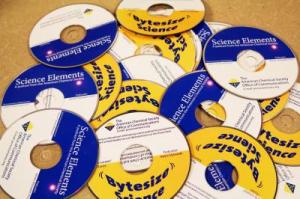CO2 gas from large chimneys can be effective in producing DVDs and CD-ROMs
Chemists say carbon dioxide emitted from large chimneys to reduce global warming in the future could become a valuable raw material in the production of DVDs and water bottles. Drink and other products made from polycarbonate plastic.
In the separate reports presented at the 235th annual meeting of the American Chemical Society (ACS) on April 8, 2008. The two doctors, Thomas E. Müller and Toshiyasu Sakakura, described the methods. Innovative method of manufacturing polycarbonate plastic from CO2. Researchers agree that these manufacturing processes bring potential products to consumers at less cost, safer and greener than existing production methods.
Müller said 'CO 2 is already available, especially from large flue gases from coal and other fossil fuels industries' . He is currently working for a new catalyst research center called CAT - a 5-year collaboration project between RWTH Aachen University, Bayer Material Science AG and Bayer Technology Services GmbH ( Virtue). 'CO 2 is a very cheap starting material. If we can replace more expensive starting materials with CO2, then we will have a boost to the economy. '

Chemists have discovered a 'greener' way to produce plastic from CO2 emissions, such as those found in CDs or drinking water bottles. (Photo: American Chemical Society)
In another ACS presentation, Japanese scientists also reported using carbon dioxide as an alternative raw material to convert carbonate and urethane into plastic and other battery components. Sakakura, the research leader, notes that the new process will be simpler and faster than the process of a Japanese factory invented. Sakakura is working for the National Institute for Advanced Industrial Science and Technology in Tsukuba, Japan.
Müller said that millions of tons of polycarbonates are sold every year with an increasing number. He added: perhaps there is no other consumer product that has such a great potential for the conversion of CO2 from the environment. These tough and durable materials represent 'interesting material depots' of CO2 emissions, and are key to the production of eyeglasses, automotive headlight lenses, DVDs and CDs, drinking water bottles. , and is the idea range for other consumer products.
Keeping CO2 in these plastics will prevent the release of millions of tons of gas into the environment, Müller said. 'Using CO2 to make polycarbonates may not solve the whole problem of CO2, but this could also be an important contribution.'
Consumers may be drinking water from a bottle of CO2-made water bottles and watching movies on DVDs made from CO2 emissions at an earlier time than they thought. 'I mean, it's just a matter of a few years before the making of CO2-based plastics is put into public use .'
- From the Lego toy model: There is an effective remedy for anthrax
- Will pirated DVDs become extinct because of DVD chips?
- Distinguish different types of DVDs in the market
- Time to finish for DVD?
- DVDs made of gold can hold up to 2,000 movies
- 90% of sharks disappear due to hunting
- Producing bricks from ... plastic waste
- First experiment with LHC large particle accelerator
- Conceptual design of large plutonium nuclear reactor
- Effective online data storage service
- Triclabendazole is effective for treatment of large liver fluke
- Producing wind power and solar power is cheaper than coal
 Is the magnetic North Pole shift dangerous to humanity?
Is the magnetic North Pole shift dangerous to humanity? Washington legalizes the recycling of human bodies into fertilizer
Washington legalizes the recycling of human bodies into fertilizer Lightning stone - the mysterious guest
Lightning stone - the mysterious guest Stunned by the mysterious sunset, strange appearance
Stunned by the mysterious sunset, strange appearance